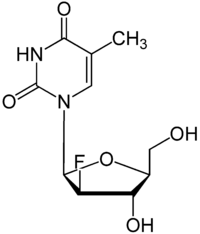Clevudin
aus Wikipedia, der freien Enzyklopädie
| Strukturformel | ||||||||||||||||
|---|---|---|---|---|---|---|---|---|---|---|---|---|---|---|---|---|

| ||||||||||||||||
| Allgemeines | ||||||||||||||||
| Freiname | Clevudin | |||||||||||||||
| Andere Namen |
| |||||||||||||||
| Summenformel | C10H13FN2O5 | |||||||||||||||
| Externe Identifikatoren/Datenbanken | ||||||||||||||||
| ||||||||||||||||
| Arzneistoffangaben | ||||||||||||||||
| ATC-Code | ||||||||||||||||
| Wirkstoffklasse | ||||||||||||||||
| Eigenschaften | ||||||||||||||||
| Molare Masse | 260,22 g·mol−1 | |||||||||||||||
| Aggregatzustand |
fest | |||||||||||||||
| Schmelzpunkt | ||||||||||||||||
| Sicherheitshinweise | ||||||||||||||||
| ||||||||||||||||
| Soweit möglich und gebräuchlich, werden SI-Einheiten verwendet. Wenn nicht anders vermerkt, gelten die angegebenen Daten bei Standardbedingungen (0 °C, 1000 hPa). | ||||||||||||||||
Clevudin oder L-FMAU [kurz für 1-(2-Fluoro-5-methyl-β, L-arabinofuranosyl)uracil] ist ein chemisches Analogon des Nukleosids Thymidin, bzw. seines spiegelbildlich aufgebauten Enantiomers Telbivudin, da es, wie dieses, die umgekehrte Stereokonfiguration von Thymidin besitzt. Es ist ein Virustatikum aus der Gruppe der Nukleosid-Reverse-Transkriptase-Inhibitoren (NRTI) und soll als Arzneistoff zur Behandlung von Hepatitis B eingesetzt werden.
Versuchte Einführung als Medikament
[Bearbeiten | Quelltext bearbeiten]Der Arzneistoff wurde 2006 als Levovir in Südkorea zur Verwendung gegen Hepatitis B durch den Hersteller Bukwang von den dortigen Behörden zugelassen.[3][4]
Seit Ende 2009 wurde jedoch über das Auftreten von Myopathie (Muskelschwäche) bei Patienten berichtet, die über 6–8 Monate mit Clevudin behandelt wurden.[5][6] Die Phase-III-QUASH-Studien zur Behandlung von Hepatitis B in den USA wurde daraufhin von Pharmasset Inc. eingestellt.[4] Dabei soll die Mehrzahl der Fälle erst nach einem Jahr Behandlung aufgetreten sein. Die Nebenwirkung soll auftreten, weil Clevudin nicht nur in die virale, sondern auch in mitochondriale DNA eingebaut wird.[4]
Pharmakologie
[Bearbeiten | Quelltext bearbeiten]Das Nukleosid Clevudin wird in der Zelle zum Nukleotid phosphoryliert. In Konkurrenz mit dem natürlichen Nukleotid Desoxythymidintriphosphat (dTTP) wird Clevudin-triphosphat in die DNA von Viren eingebaut. Der Einbau des Fluor-nukleosidtriphosphats führt zum Kettenabbruch und zur Hemmung der virale reverse Transkriptase.
Einzelnachweise
[Bearbeiten | Quelltext bearbeiten]- ↑ The Merck Index. An Encyclopaedia of Chemicals, Drugs and Biologicals. 14. Auflage. 2006, ISBN 978-0-911910-00-1, S. 394–395.
- ↑ Dieser Stoff wurde in Bezug auf seine Gefährlichkeit entweder noch nicht eingestuft oder eine verlässliche und zitierfähige Quelle hierzu wurde noch nicht gefunden.
- ↑ Bukwang Launches New Hepatitis Drug. In: pharmaceuticalsinsight.com. November 2006, archiviert vom am 16. Oktober 2013; abgerufen am 5. Juli 2012.
- ↑ a b c R. D. Fleischer, A. S. Lok: Myopathy and neuropathy associated with nucleos(t)ide analog therapy for hepatitis B. In: J. Hepatol. Band 51, Nr. 4, Oktober 2009, S. 787–791, doi:10.1016/j.jhep.2009.06.011, PMID 19665816.
- ↑ B. K. Kim, J. Oh, S. Y. Kwon, W. H. Choe, S. Y. Ko, K. H. Rhee, T. H. Seo, S. D. Lim, C. H. Lee: Clevudine myopathy in patients with chronic hepatitis B. In: J. Hepatol. Band 51, Nr. 4, Oktober 2009, S. 829–834, doi:10.1016/j.jhep.2009.04.019, PMID 19615776.
- ↑ J. I. Seok, D. K. Lee, C. H. Lee, M. S. Park, S. Y. Kim, H. S. Kim, H. Y. Jo, C. H. Lee, D. S. Kim: Long-term therapy with clevudine for chronic hepatitis B can be associated with myopathy characterized by depletion of mitochondrial DNA. In: Hepatology. Band 49, Nr. 6, Juni 2009, S. 2080–2086, doi:10.1002/hep.22959, PMID 19333909.
Text is available under the CC BY-SA 4.0 license; additional terms may apply.
Images, videos and audio are available under their respective licenses.
